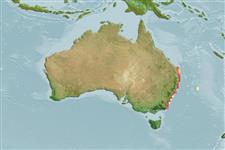Environment: milieu / climate zone / depth range / distribution range
Ecology
Marine; reef-associated; non-migratory. Temperate; 25°S - 39°S, 147°E - 161°E (Ref. 56289)
Southwest Pacific.
Size / Weight / Age
Maturity: Lm ? range ? - ? cm
Max length : 45.0 cm TL male/unsexed; (Ref. 33839)
Occurs inshore (Ref. 7300). Benthic (Ref. 75154).
Life cycle and mating behavior
Maturities | Reproduction | Spawnings | Egg(s) | Fecundities | Larvae
Paxton, J.R., D.F. Hoese, G.R. Allen and J.E. Hanley, 1989. Pisces. Petromyzontidae to Carangidae. Zoological Catalogue of Australia, Vol. 7. Australian Government Publishing Service, Canberra, 665 p. (Ref. 7300)
IUCN Red List Status (Ref. 130435)
Threat to humans
Harmless
Human uses
Tools
Special reports
Download XML
Internet sources
Estimates based on models
Preferred temperature (Ref.
123201): 19.3 - 24.4, mean 22.3 °C (based on 22 cells).
Phylogenetic diversity index (Ref.
82804): PD
50 = 0.5005 [Uniqueness, from 0.5 = low to 2.0 = high].
Trophic level (Ref.
69278): 4.1 ±0.7 se; based on size and trophs of closest relatives
Resilience (Ref.
120179): Medium, minimum population doubling time 1.4 - 4.4 years (Preliminary K or Fecundity.).
Fishing Vulnerability (Ref.
59153): Low to moderate vulnerability (35 of 100).
Nutrients (Ref.
124155): Calcium = 10.7 [5.6, 23.5] mg/100g; Iron = 0.171 [0.083, 0.323] mg/100g; Protein = 17.8 [15.2, 20.9] %; Omega3 = 0.418 [0.227, 0.751] g/100g; Selenium = 7.55 [3.45, 16.60] μg/100g; VitaminA = 66.8 [17.7, 297.0] μg/100g; Zinc = 0.476 [0.306, 0.737] mg/100g (wet weight);
